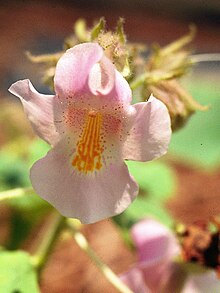
An apricot is a fruit, or the tree that bears the fruit, of several species in the genus Prunus.

Daucus carota, whose common names include wild carrot, European wild carrot, bird's nest, bishop's lace, and Queen Anne's lace, is a flowering plant in the family Apiaceae. It is native to temperate regions of the Old World and was naturalized in the New World.
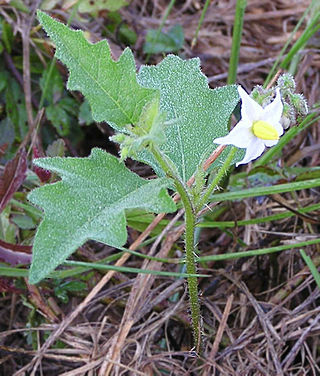
Solanum carolinense, the Carolina horsenettle, is not a true nettle, but a member of the Solanaceae, or nightshade family. It is a perennial herbaceous plant, native to the southeastern United States, though its range has expanded throughout much of temperate North America. The plant is an invasive in parts of Europe, Asia, and Australia. The stem and undersides of larger leaf veins are covered with prickles.

Passiflora incarnata, commonly known as maypop, purple passionflower, true passionflower, wild apricot, and wild passion vine, is a fast-growing perennial vine with climbing or trailing stems. A member of the passionflower genus Passiflora, the maypop has large, intricate flowers with prominent styles and stamens. One of the hardiest species of passionflower, it is both found as a wildflower in the southern United States and in cultivation for its fruit and striking bluish purple blooms.

Pedaliaceae, the pedalium family or sesame family, is a flowering plant family classified in the order Lamiales. The family includes sesame, the source of sesame seeds.
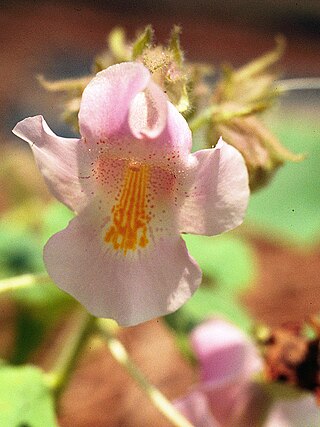
Proboscidea is a genus of flowering plant in the family Martyniaceae, some of whose species are known as devil's claw, devil's horn, ram's horn, or unicorn plant. The plants produce long, hooked seed pods. The hooks catch on the feet of animals, and as the animals walk, the pods are ground or crushed open, dispersing the seeds. The name devil's claw is shared with the South African plant Harpagophytum procumbens.

Opuntia ficus-indica, the Indian fig opuntia, fig opuntia, or prickly pear, is a species of cactus that has long been a domesticated crop plant grown in agricultural economies throughout arid and semiarid parts of the world. O. ficus-indica is the most widespread and most commercially important cactus. It is grown primarily as a fruit crop, and also for the vegetable nopales and other uses. Cacti are good crops for dry areas because they efficiently convert water into biomass. O. ficus-indica, as the most widespread of the long-domesticated cactuses, is as economically important as maize and blue agave in Mexico. Opuntia species hybridize easily, but the wild origin of O. ficus-indica is likely to have been in central Mexico, where its closest genetic relatives are found.

Miconia calvescens, the velvet tree, miconia, or bush currant, is a species of flowering plant in the family Melastomataceae. It is native to Mexico and Central and South America and it has become one of the world's most invasive species.

Martyniaceae is a family of flowering plants in the Lamiales order that are restricted to the Americas. The family was included in Pedaliaceae in the Cronquist system but is recognized as a separate family by the Angiosperm Phylogeny Group on the basis of phylogenetic studies that show that the two families are not closely related. Both families are characterized by having mucilaginous hairs — which give the stems and leaves a slimy or clammy feel — and fruits with hooks or horns. Some members of the genus Proboscidea are known as "unicorn plant" or "devil's claw" because of their horned seed capsules.
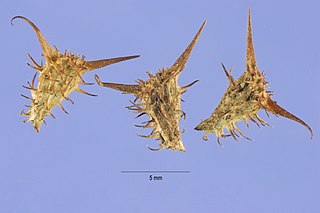
Goat's head is a common name for several plants and may refer to:
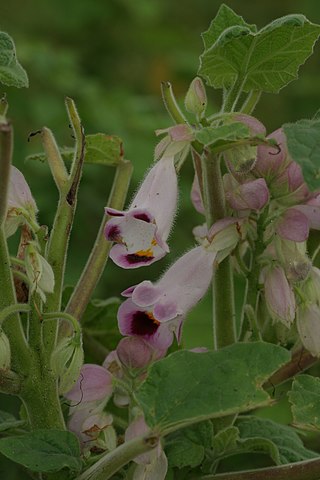
Martynia is a monotypic genus in the Martyniaceae family consisting of a single species, Martynia annua L., which is commonly known as cat's claw, tiger's claw, iceplant. or Devil's claw. However, the name 'iceplant' may also refer to members of the unrelated plant family Aizoaceae.

Perilla frutescens, also called deulkkae or Korean perilla, is a species of Perilla in the mint family Lamiaceae. It is an annual plant native to Southeast Asia and Indian highlands, and is traditionally grown in the Korean peninsula, southern China, Japan and India as a crop.

Chorispora tenella is a species of flowering plant in the mustard family known by several common names, including purple mustard, blue mustard, musk mustard, and crossflower. This mustard is native to parts of Eurasia but is well known in other parts of the world, particularly in temperate regions, as an introduced species and a noxious weed.
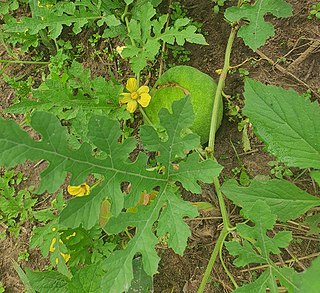
Melothria sphaerocarpa is a species of melon native from southern Mexico and the Dominican Republic through Central America to tropical South America. It has been introduced to western tropical Africa, where has been known under the synonym Cucumeropsis mannii, and is grown for food and as a source of oil, more often for the seed oil than for the fruit.

A pitaya or pitahaya is the fruit of several different cactus species indigenous to the region of southern Mexico and along the Pacific coasts of Guatemala, Costa Rica, and El Salvador. Pitaya is cultivated in East Asia, South Asia, Southeast Asia, the United States, the Caribbean, Australia, Brazil, and throughout tropical and subtropical regions of the world.

Proboscidea althaeifolia is a species of flowering plant in the family Martyniaceae known by the common names desert unicorn-plant and yellow-flowered devil's claw. It is native to the desert southwest of the United States, where it grows in sandy habitat and blooms during the hot summer. This is a perennial herb growing from a thick, tuberlike yellow root. The stem is decumbent, creeping along the ground. The shiny leaves have rounded, oval, or roughly triangular blades up to 7 centimeters long which are deeply lobed and wavy along the edges. The inflorescence is an array of many showy, fragrant, bell-shaped flowers with five lobes flaring several centimeters wide. The flower is yellow to orange or apricot with an intricate pattern of speckles and streaks, its lower lobe lined with a nectar guide. The fruit is a large seed pod many centimeters long, a cylindrical body tapering into a very long, thin, curving tail. As the fruit dries the tail cracks open and splits into two hooked, claw-like halves. These hard, dry fruits were used as tools by local Native Americans.

Proboscidea parviflora is a species of flowering plant in the family Martyniaceae known by the common names doubleclaw and red devil's-claw. It is native to the desert southwest of the United States and northern Mexico, where it grows in sandy, dry, and disturbed habitat and blooms during the hot summer. This is an annual herb growing from a taproot and producing sprawling, spreading stems. The leaves have rounded, oval, or roughly triangular blades up to 15 centimetres (6 in) long which have smooth edges or faint lobes or teeth. The inflorescence is an array of several showy bell-shaped flowers with five lobes flaring several centimeters wide. The flower is white to pink or purple, sometimes with mottling or lines of spots in the throat, and often a purple blotch on the upper lip. A yellow nectar guide extends along the lower lip. The fruit is a large seed pod many centimeters long, a cylindrical body tapering into a very long, thin, curving tail. As the fruit dries the tail cracks open and splits into two hooked, claw-like halves. The young fruits and seeds were used for food and the dark-colored hardened dry fruits were used in basketry by local Native Americans.

Trianthema portulacastrum is a species of flowering plant in the ice plant family known by the common names desert horsepurslane, black pigweed, and giant pigweed. It is native to areas of several continents, including Africa and North and South America, and present as an introduced species in many other areas. It grows in a wide variety of habitat types and it can easily take hold in disturbed areas and cultivated land as a weed.
Proboscidea sabulosa is a species of flowering plant in the family Martyniaceae known by the common names sanddune unicorn-plant, dune unicorn plant and dune devil's claw. It is native to Chihuahua in Mexico and New Mexico and Texas in the United States.

Stachys floridana is a species of betony in the mint family, Lamiaceae. It is native to the United States, where its true native range is probably limited to Florida, but today it is known throughout the Southeast as an introduced species and common weed. It occurs as far west as Texas, and it has been recorded in California. Its common names include Florida betony, Florida hedgenettle, and rattlesnake weed. It has been called wild artichoke, but it is not closely related to artichoke. The plant was the Florida Department of Agriculture's "Weed of the Month" for February 2010.
